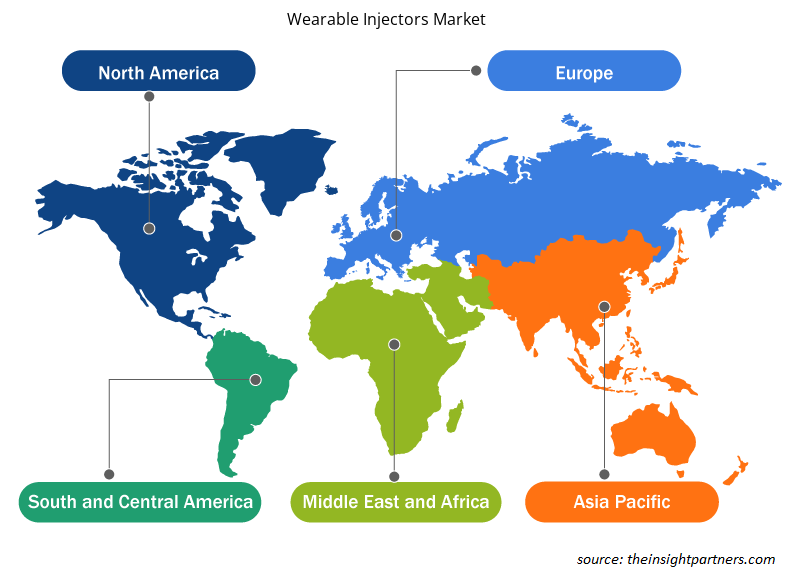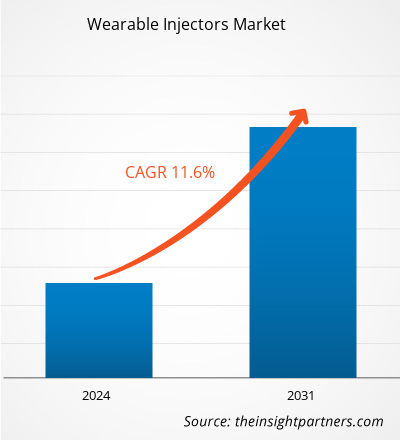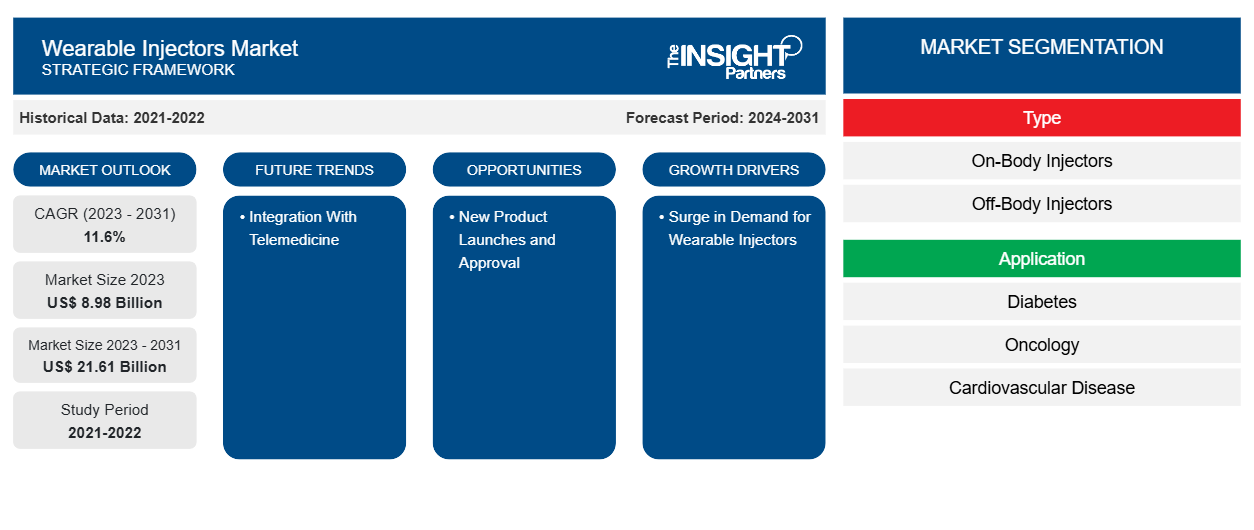2023 年可穿戴注射器市场价值为 89.8 亿美元,预计到 2031 年将达到 216.1 亿美元。预计 2023-2031 年市场复合年增长率为 11.6%。与远程医疗的整合可能仍是可穿戴注射器市场的主要趋势。
可穿戴注射器市场分析
慢性病患病率的上升是推动可穿戴注射器市场的一个因素。老龄化人口也利用了可穿戴医疗技术,因为急性和慢性疾病在世界范围内变得越来越普遍。可穿戴医疗设备的出现恰逢 COVID-19 大流行。例如,根据世界卫生组织的数据,全球约有 4.22 亿人患有糖尿病,其中大多数居住在中低收入国家。该疾病每年直接导致 150 万人死亡。
可穿戴注射器市场概况
由于技术的发展、人们对这些设备的健康意识不断提高以及对个性化医疗保健的需求不断增长,可穿戴医疗设备领域前景光明。由于这些设备的技术进步和创新,可穿戴注射设备市场预计将在新兴国家增长。心血管疾病和糖尿病的增加预计将大大加速市场扩张。例如,预计在中国,2020 年至 2030 年间,20 至 79 岁糖尿病患者的比例将从 8.2% 上升至 9.7%。
定制此报告以满足您的需求
您可以免费定制任何报告,包括本报告的部分内容、国家级分析、Excel 数据包,以及为初创企业和大学提供优惠和折扣
-
获取此报告的关键市场趋势。这个免费样品将包括数据分析,从市场趋势到估计和预测。
可穿戴注射器市场驱动因素和机遇
可穿戴注射器需求激增,市场前景看好
公司致力于向消费者提供可穿戴健康技术并确保其有益。医疗生态系统中的可穿戴设备市场正在迅速增长。根据美国国立卫生研究院的信息,大约 30% 的美国成年人使用可穿戴医疗技术,几乎一半的人每天都在使用以应对复杂的医疗状况。据报道,几家企业正在竞相成为第一个销售可穿戴血压监测仪的公司,这种监测仪有可能取代传统的医院检测。可穿戴注射器行业有望无缝融入日常生活,在医疗保健革命中不可或缺。这些设备已经发展并获得了关注。由于嵌入式系统、传感技术、纳米技术和小型化的进步,智能医疗系统正在成为可能。注射器使用方便、舒适,具有灵活剂量、防水和冷藏药物自动加热等特点。由于这些优势,对注射器的需求日益增长。
新产品发布和审批——可穿戴注射器市场的机遇
由于全球大量人口对可穿戴注射器的需求不断增加,医疗保健行业正在持续快速发展,这增加了全球新产品的开发、产品发布和批准。此外,主要的市场参与者参与研发活动,以确保高效产品的创新和开发。近年来,市场上发生了各种发展,例如产品发布和批准,可能会创造充足的机会。例如,2024 年 2 月,领先的制药技术公司 LTS LOHMANN Therapie-Systeme AG 宣布其客户之一 Coherus BioSciences, Inc. 推出了 UDENYCA 随身注射器 (OBI),它利用了 LTS Sorrel 可穿戴药物输送平台。) 生物仿制药培非格司亭,称为 UDENYCA (pegfilgrastim-cbqv),在化疗后的第二天给药,以降低发热性中性粒细胞减少症所指示的感染风险。美国食品药品监督管理局(FDA)于2024年12月批准了UDENYCA OBI。
可穿戴注射器市场报告细分分析
可穿戴注射器市场分析的关键部分包括类型、应用程序和最终用户。
- 根据类型,可穿戴注射器市场分为体内注射器和体外注射器。体内注射器部分在 2023 年占据了较大的市场份额。
- 根据应用,市场细分为糖尿病、肿瘤学、心血管疾病、自身免疫性疾病和其他应用。2023年,肿瘤学领域占据了最大的市场份额。
- 根据最终用户,可穿戴注射器市场分为医院和诊所、家庭护理环境、其他最终用户。
可穿戴注射器市场份额按地区分析
可穿戴注射器市场报告的地理范围分为五个地区:北美、亚太、欧洲、中东和非洲、南美/南美和中美。
北美主导了可穿戴注射器市场。在北美,美国是 2023 年最大的可穿戴注射器市场。糖尿病、癌症、肿瘤、心血管疾病等慢性病患病率的增加是北美市场不断增长的特征。除了新产品的创造和该领域重要市场参与者的存在。此外,美国糖尿病发病率的上升预计将支持该国可穿戴注射器市场的扩张。根据美国疾病控制和预防中心 (CDC) 2021 年全国糖尿病统计报告,约有 3730 万美国人患有糖尿病,其中 145 万为 1 型糖尿病患者。在北美,由于癌症发病率上升,可穿戴注射器的需求预计将增加。例如,2022 年,美国癌症协会报告称,发现了约 190 万例新癌症病例。美国最常见的癌症包括黑色素瘤、前列腺癌和乳腺癌。此外,医疗技术的发展将为北美的可穿戴注射器市场创造重大机遇。
可穿戴注射器市场区域洞察
Insight Partners 的分析师已详尽解释了预测期内影响可穿戴注射器市场的区域趋势和因素。本节还讨论了北美、欧洲、亚太地区、中东和非洲以及南美和中美洲的可穿戴注射器市场细分和地理位置。

- 获取可穿戴注射器市场的区域特定数据
可穿戴注射器市场报告范围
| 报告属性 | 细节 |
|---|---|
| 2023 年的市场规模 | 89.8亿美元 |
| 2031 年市场规模 | 216.1亿美元 |
| 全球复合年增长率(2023 - 2031) | 11.6% |
| 史料 | 2021-2022 |
| 预测期 | 2024-2031 |
| 涵盖的领域 |
按类型
|
| 覆盖地区和国家 |
北美
|
| 市场领导者和主要公司简介 |
|
可穿戴注射器市场参与者密度:了解其对业务动态的影响
可穿戴注射器市场正在快速增长,这得益于终端用户需求的不断增长,而这些需求又源于消费者偏好的不断变化、技术进步以及对产品优势的认识不断提高等因素。随着需求的增加,企业正在扩大其产品范围,进行创新以满足消费者的需求,并利用新兴趋势,从而进一步推动市场增长。
市场参与者密度是指在特定市场或行业内运营的企业或公司的分布情况。它表明在给定市场空间中,相对于其规模或总市场价值,有多少竞争对手(市场参与者)存在。
可穿戴注射器市场的主要公司有:
- 安进公司
- 美敦力
- 屋宇署
- 胰岛素公司
- Gerresheimer AG(Sensile Medical)
- 西部制药服务有限公司
免责声明:上面列出的公司没有按照任何特定顺序排列。

- 获取可穿戴注射器市场顶级关键参与者概览
可穿戴注射器市场新闻和最新发展
可穿戴注射器市场通过收集一手和二手研究后的定性和定量数据进行评估,其中包括重要的公司出版物、协会数据和数据库。以下是可穿戴注射器市场的发展和策略列表:
- Ypsomed 与瑞士全球合同开发和制造组织 ten23 health 建立合作伙伴关系。此次合作的目的是推动 YpsoDose 可穿戴注射器的商业化,用于皮下自我注射大剂量药物。ten23 的药物开发、灌装和设备组装专业知识将为产品供应做出重大贡献。(来源:Ypsomed 公司名称,新闻稿,2024 年)
- Eitan Medical 是先进输液治疗和药物输送解决方案领域的全球领导者,拥有可靠的创新技术,将患者置于护理的中心。该公司欣然宣布,其可穿戴注射器业务已成功出售并过渡至 LTS,后者是一家领先的制药技术公司,开发和制造创新药物输送系统。此次战略收购标志着两家公司的一个里程碑,并为以患者为中心的药物输送系统领域的进一步发展奠定了基础。(来源:Eitan Medical 公司名称,简报,2023 年)
可穿戴注射器市场报告覆盖范围和交付成果
“可穿戴注射器市场规模和预测(2021-2031)”报告对市场进行了详细的分析,涵盖以下领域:
- 范围内所有主要细分市场的全球、区域和国家层面的市场规模和预测
- 市场动态,如驱动因素、限制因素和关键机遇
- 未来的主要趋势
- 详细的 PEST/波特五力分析和 SWOT 分析
- 全球和区域市场分析涵盖关键市场趋势、主要参与者、法规和最新市场发展
- 行业格局和竞争分析,涵盖市场集中度、热点图分析、知名参与者和最新发展
- 详细的公司简介
- 历史分析(2 年)、基准年、预测(7 年)及复合年增长率
- PEST和SWOT分析
- 市场规模、价值/数量 - 全球、区域、国家
- 行业和竞争格局
- Excel 数据集
近期报告
客户评价
购买理由
- 明智的决策
- 了解市场动态
- 竞争分析
- 客户洞察
- 市场预测
- 风险规避
- 战略规划
- 投资论证
- 识别新兴市场
- 优化营销策略
- 提升运营效率
- 顺应监管趋势























 获取免费样品 - 可穿戴注射器市场
获取免费样品 - 可穿戴注射器市场